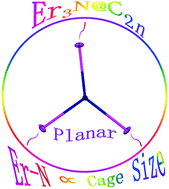Crystallographic characterization of Er3N@C2n (2n = 80, 82, 84, 88): the importance of a planar Er3N cluster†
Abstract
A series of Er-based nitride clusterfullerenes (NCFs), Er3N@C80–88, have been successfully synthesized and isolated. In particular, Er3N@Ih(7)-C80, Er3N@D5h(6)-C80, Er3N@C2v(9)-C82, Er3N@Cs(51365)-C84, and Er3N@D2(35)-C88 have been characterized by single-crystal X-ray diffraction (XRD) for the first time. The planar configuration of the inserted Er3N cluster is identified unambiguously and the Er–N distances increase in accordance with cage expansion to maintain strong metal–cage interactions. Additionally, the electrochemical properties of the Er3N@C80–88 series are studied by means of cyclic voltammetry. It is found that the first reduction potentials are roughly similar for all compounds under study, while the first oxidation potentials are cathodically shifted along with the increase of the cage size in the Er3N@C2n (2n = 80, 84, 86, 88) series, leading to a decrease in the corresponding electrochemical band gaps. Nevertheless, for Er3N@C2v(9)-C82, a good electron donating ability is manifested by its relatively small first oxidation potential, which results from the relatively higher energy level of the highest occupied molecular orbital. The redox behaviors observed in such Er3N-based NCFs may promise their great potential applications in donor–acceptor systems.



 Please wait while we load your content...
Please wait while we load your content...